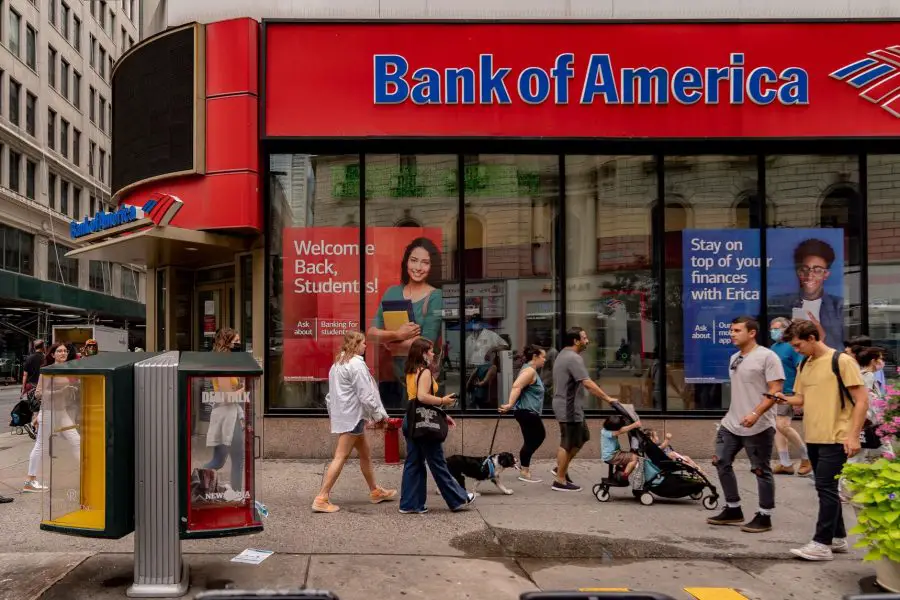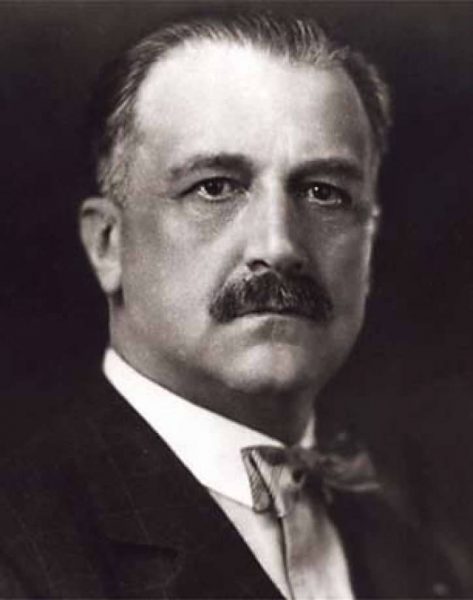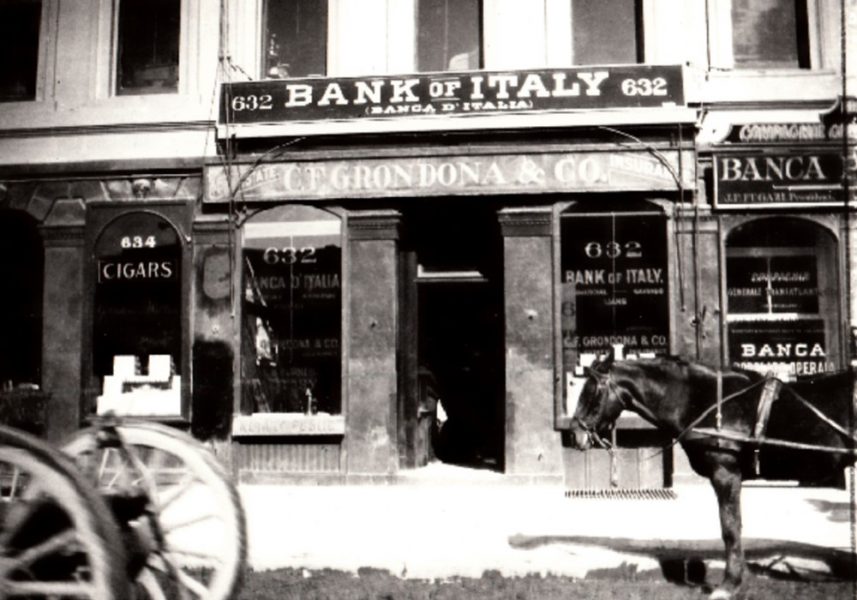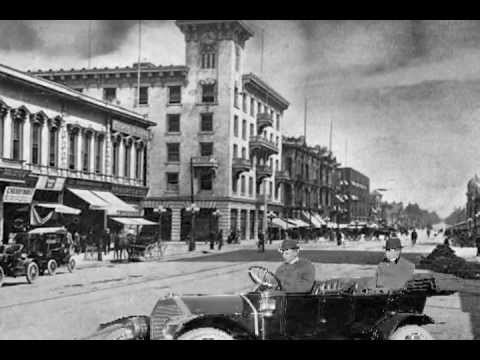
The Bank of America is the eighth-largest banking institution in the world and the second-largest in the United States (1st – JP Morgan Chase). Bank of America accounts for roughly 11% of all deposits in the United States.
Its humble beginnings can be traced back to 1904 and an Italian American man named Amadeo Peter Giannini, who became known as “America’s banker” due to his long-lasting impact on the banking industry in the United States. Without his contributions, the Bank of America would not be what it is today.

Columbus Savings & Loans
At the age of 14, Amadeo quit school to become a produce broker in the family business. From trading vegetables with farmers throughout Santa Clara, Amadeo progressed on to eventually take over his stepfather’s vested interest in Columbus Saving & Loans. Upon Lorenzo’s passing, Amadeo assumed control of Columbus Savings & Loans.
He had observed that many ordinary people, especially immigrants, were denied access to many banks — only the upper class were serviced for their banking needs. Many citizens had to resort to dubious means of banking: loan sharks or hiding money in their mattresses.
At that time, there was a surge in Italian immigrants in California, all of whom, lacked complete access to basic modern financial services. As an Italian himself, Amadeo saw an opportunity to expand the reach of Columbus Saving & Loans by opening up banking to everyone, not just wealthy clients.
Rejection & Inspiration
Any attempts that Amadeo made were swatted down by other directors. Frustrated, he resigned from the company. Instead of feeling defeated, the ex-director found himself on the brink of a new banking industry. Wanting to make a change, he decided to take it upon himself to make it his reality.
“I might never have gone into the banking business if I hadn’t got so damn mad at those directors.”
Amadeo Giannini
The Unorthodox Bank of Italy

“I’m going to start my own bank.”
Amadeo Giannini
On October 17, 1904, Amadeo and five investors founded a small bank named the Bank of Italy (BoI) with $150,000 in funding from his friends and family.
The Bank of Italy’s first building was a repurposed saloon across the Columbus Saving & Loans building. Amadeo stated that the banking institution was for the “little fellow.” Diligent workers who were denied service at other banks finally had a bank.
With the gates opened for the public, customers flocked to the Bank of Italy and began using its services.
On its first day, roughly $8,780 were deposited ($288,350 today), and in its first year, more than $700,000 were deposited ($20M today).
The way Amadeo ran the Bank of Italy was considered completely unorthodox, but common in today’s society.
The bank offered loans as small as $25 to workers. Despite the smaller dollar amount of loans, more customers could take out loans. Giannini set loan criteria based on a borrower’s characteristics in honoring a debt, not the size of their bank account. Hitting the pavement, he advertised his bank by promoting his bank door-to-door when most banks didn’t, introducing more and more customers to his bank. In the process, he also explained and educated the people on the value of banking security and financial principles. He introduced them to subjects ranging from how to register for a bank account to compound interest.
Open to the public at late hours of the day, workers whose shifts were ending late were able to deposit their funds and access their accounts. The most iconic policy is that the Bank of Italy allowed anyone to make a bank account or apply for a loan. Since the bank served everyone, the sheer volume of clients contributed to immediate growth. BoI had the lowest loan interest rates and recipients could even extend their payment terms without incurring standard fees. Despite the then-abnormal method of banking models, the Bank of Italy’s deposits and regular customers kept increasing.
The Bank of Italy’s financial performance outperformed other banks’ because of its unique but beneficial strategies.
However, its first disaster began to brew two years after out of the womb.
The 1906 San Francisco Earthquake
In the early morning of April 18, 1906, a massive 7.9 earthquake destroyed more than 80% of San Francisco, while fire burned much of the rest and what remained.
One of the most lethal earthquakes in U.S. history, it crumbled structures, severed pipelines and wires, and shook the foundations of every structure.
Gas from the main pipelines burst into flames, causing a massive fire to burn throughout San Francisco. The fire spread all the way to the outskirts of the city and burned for a full four days.
The earthquake resulted in more than 3,000 fatalities, 400,000 residents homeless, and uncountable losses for San Franciscan business owners.


For banking institutes, they were not spared by the earthquake. Many bank buildings themselves were incinerated by the blaze except for the metal vaults. Many presumed that the records and money were safe inside. Yet, the vaults were heated by the fire to the point where if carelessly opened, the result would have been instant incineration of all money inside from the sudden rush of oxygen, and subsequent combustion. Many banks weren’t able to open the vault safely for several days to weeks, which deprived users of access when they needed funds most.
Fortunately, the Bank of Italy was outside the city center. After the earthquake ended and as the fires started, Amadeo rushed to the Bank of Italy to retrieve all of the deposits and records. Then, he loaded them into a garbage wagon (borrowed from a garbage collector) and covered it with garbage to disguise it from thieves. He managed to drive it to his home somewhere in San Manteo, just around 15 miles away.
While many banks’ services were disrupted by the disaster, Amadeo’s bank was one of the first to recover. After the fires died out, Amadeo set up a temporary bank, composed of a plank stacked on two barrels, on the North Beach Wharf with its operations continued as nothing significant happened. He offered loans “on a handshake” to residents and sellers who needed funding to rebuild their homes or businesses, quickly making headlines.
Years passed by, and the city was finally rebuilt and every loan was paid back, with interest.
Amadeo Giannini’s efforts directly supported the reconstruction of the city of San Francisco.
“San Francisco will rise from the ashes!”
Amadeo Giannini
Becoming The Big Fish
“By opening branches, I foresaw that we could give better service to everybody.”
Amadeo Giannini
In the year 1909, the State of Washington Legislation issued amended session laws on banking allowing banks to branch out into smaller outlets throughout California.
From barrels to new banking branches, Amadeo pushed the Bank of Italy forward. Eager to seek out more customers for his business and further stabilize his financial system, a new law enabled banks to branch out. The ex-produce broker revisited his hometown, San Jose, to acquire a local bank to form his first branch.
As the acquisition continued throughout the years, and by 1918, there were 24 Bank of Italy branches, resulting in becoming the first bank to have state-wide coverage. Amadeo was relentless about the branching of the bank, constantly buying franchises and rebranding.
Later on, to give their clients the comfort of communicating in their native language, Amadeo formed new departments where bank tellers and employees could converse in Chinese, Greek, French, Portuguese, Yugoslavian, Slovenian, Russian, and Spanish. In response to the higher number of women running their businesses, Amadeo also created an office for women to service female customers.
And occasionally, Amadeo strolled into his branches to greet his employees. Reportedly, Amadeo Giannini could remember the names of every employee AND their children.
The Merger of the Bank of Italy and the Bank of America
The 1909 version of Bank of America was based in Los Angeles, formed by a banker named Orra Eugene Monnette. Funded by his father’s silver mine, Orra established his first location by purchasing enough stock to merge two banks to become Citizens Trust and Savings Bank.
Orra’s company caught Amadeo’s attention because of its streamlined accounting and distribution network. Amadeo began investing in Orra’s bank as he had difficulty negotiating expansion in Los Angeles. Intent on expanding beyond the premises of San Francisco, Amadeo went to Orra’s office to convince him to merge with the Bank of Italy. To persuade Orra, Amadeo shared his worries about the future of the American economy.
Orra, who had been considering retirement and had no successors, agreed to merge with the Bank of Italy. Both founders agreed that the name of the new bank would be The Bank of America to prepare itself for expansion throughout the country.
On November 1st, 1930, the companies finalized the merger, becoming the largest banking institution in North America.
After more than 40 years since the establishment of the Bank of Italy, Amadeo retired from directorship.
On June 3rd, 1949, Amadeo Peter Giannini passed away at the age of 79 due to heart disease. His final resting place is located at Holy Cross Cemetary in a town named Colma, California. At his funeral, reportedly thousands of people he had helped, visited the gravesite to honor Amadeo’s contributions to their lives and work.
Amadeo’s Legacy
“No one owns a fortune, it owns him.”
Amadeo Giannini
In his years in the position of chairman of the Bank of Italy and co-founder of the Bank of America, Amadeo has left a lasting impact on the state of California. As a banker, Amadeo helped fund the local economy of California. Many notable companies and a few landmarks wouldn’t exist today without Amadeo Giannini’s help.
Amadeo decided to support California’s agriculture industry because of its importance in the economy and the well-being of the residents. The state of California currently leads in agricultural exports in the United States in dairy, grapes, and almonds. Furthermore, other states have to import wine from California as 95% of it was produced there.
Amadeo had realized its potential as he frequently traveled down the countryside to meet up with his clients and converse with the agriculturalists working in the fields. By offering loans to the farming organizations, Amadeo helped modernize the cultivation of produce and wine production. Many organizations and companies were able to cultivate more products and improve their quality.
Sun-Maid, an iconic brand of raisins, improved the scale of its manufacturing and became one of the largest raisin producers in North America.
Giannini Funded Disney
Walt Disney, a pioneer of American animation, currently cryogenically frozen somewhere, had decided to make the company’s first feature film. In 1934, Walt Disney wanted to make a film that was considered long enough to cover the course of an entire entertainment program by animating the story of Snow White. Walt’s brother Roy Disney, then co-founder of the studio, stated that doing so would completely wipe out the studio’s reserve funds, essentially rendering it bankrupt.
Throwing caution to the wind, Walt powered forward, determined to launch the film. Many at the time regarded the film as “madness,” and even Hollywood called it “Disney’s Folly.”
Amadeo heard of the production and offered Roy Disney a loan to pay the animator’s wages, production costs, and the nationwide ad campaign; Walt and Roy accepted.
After the release of Snow White and the Seven Dwarves in 1937, the Disney brothers were astonished by ludicrous profits, becoming one of the highest-grossing films overnight.
Also funded by Amadeo: MGM’s Gone with the Wind, West Side Story, and Lawrance of Arabia.
Amadeo Giannini Backs Golden Gate Bridge Project
The Californian Legislature green-lighted the Golden Gate Bridge’s planning, construction, and management in 1928. Unfortunately, the Golden Gate Bridge construction did not begin until 1934, right in the midst of the Great Depression (1929-1939). Throughout the disruptions in project funding, bonds amounting to $30 million were drawn, valued at approximately half a billion dollars today. Coming in to make sure the project was completed, Amadeo backed the Golden Gate Bridge Project as the project’s official financial guarantor.
Today, the Golden Gate Bridge became one of the world’s most iconic and beautiful bridges and still holds the record for the longest and tallest suspension bridge.
Approximately 110,000 cars cross this bridge daily.
Thank you, Amadeo Peter Giannini.
